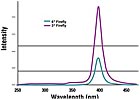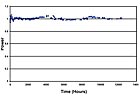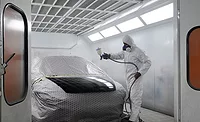Driving Automotive UV with SLMs
Solid-state UV sources based on LED technology may present automakers with a new tool to overcome some of the limitations of traditional higher power sources.

UV-cured coatings for automotive applications have been long awaited but slow to develop. While many point to the challenges of developing Class-A, high-performance, weatherable formulations, key participants in the automotive coating arena realize that equipment developments will need to play a vital role in the adoption of UV curing by automakers.
According to Mark Nichols of Ford Motor Co., "Traditional curing methods using high powered UV radiation sources to provide rapid curing pose a number of concerns for the automotive industry.... A low-cost, manufacturing friendly, slow curing system...must be developed if UV curable clear coats are ever to be used on a large scale in the automotive industry."
Solid-state UV sources based on light-emitting-diode (LED) technology may present automakers with a new tool to overcome some of the concerns and limitations of traditional higher power sources.
Over the last few decades, chemists have developed photo-sensitive materials (photo-initiators) that react with the UV light emitted from these mercury lamps to drive the UV curing of coatings and adhesives. But just as you may have noticed the gradual replacement of traditional bulbs in flashlights, traffic lights and taillights with light emitting diodes, another new solid-state illumination technology has developed rapidly in the last five years. This technology uses semiconductor devices to generate UV energy, and it promises to revolutionize the field of industrial UV curing.
High-powered arrays of semiconductor light sources are now being used commercially to produce UV-cured products in graphic arts, industrial and automotive applications. These new semiconductor light matrices (SLMs) have a number of attractive characteristics, including a pure spectral output, output stability over time, form flexibility, surface uniformity, reduced heat generation and dirt contamination, and environmental benefits.

Medium pressure mercury lamps produce a broad output, which extends from very short wavelength UV (< 200 nm) into the long wave infrared heat spectrum and beyond. Figure 1 shows the broad emission range of these lamps, and UV emission is only a fraction of the total output combined with the visible light and heat generated by mercury lamps.
By comparison, SLMs are very narrow bandwidth devices that are laser-like in their monochromatic output. Figure 2 shows the actual emission spectra of a commercial solid-state UV source measured at different target distances using a spectral radiometer. The output was measured in half nanometer slices.
The output is a single peak lying in a very narrow (<15 nm wide at the half-power shoulders) wavelength band. Most industrial solid-state sources operate in the 390-400 nm region because of the available technology and the cost/power tradeoffs of moving to shorter wavelength devices. Besides, 390-400 nm offers some advantages in that the wavelength is especially safe and above the interference of many popular additives.
The potential of SLM technology is that chemists can create a very efficient system of light and chemistry where the photoinitiator and source are well matched, and little energy is wasted in generating wavelengths that are not used for curing.
Quantifying the lifetime of a UV source is a bit of a moving target. Conventional lamps are typically specified to last from 1,000 to 8,000 production hours (depending on a wide range of factors). But usually the lamp energy diminishes over time so that while the lamp is still operating, it is producing less UV output than at startup. This degradation is affected by the number of on/off cycles, power, doping, ballast design, etc.
Solid-state UV devices are not affected by these variables. The lifetime of UV SLMs appears unaffected by turning the source on and off. The major factor affecting the lifetime of a solid-state source - proper cooling of the semiconductor junction - is not process-dependent but is dictated by the design of the SLM UV light system itself.
Figure 3 shows the actual measured output data for a solid-state UV source running for over 14,000 hours without any noticeable sign of degradation.

Individual arrays can be positioned in any orientation and will produce a uniform output. The flexibility and scalability of the SLM technology allows arrays to be constructed for virtually any physical curing task without waste or inefficiency.
SLMs can be obtained in a wide range of sizes and shapes to cure two- and three-dimensional parts. Using modular arrays, large surfaces can also be irradiated "seamlessly" by multiple sources. SLMs may be literally butted up against each other with virtually no edge effects.

Solid-state UV sources emit a fraction of the heat of conventional lamps (see Figure 4). This heat is mainly generated at the surface mounting point of the individual semiconductor devices themselves and can be conducted to the "back side" of an SLM module using a thermally conductive substrate. No cooling air is required on the emitter surface of the array, making SLM devices an ideal choice when it is important to maintain a regulated environment to avoid contamination or for other processing reasons.
The narrow output of SLMs in the relatively safe 390 nm (visible) light region eliminates concerns associated with these other wavelengths. No ozone is produced by SLMs and, as described above, little to no heat is radiated from the face of the source.
Additionally, although the amount of mercury used in the lamps themselves is tiny compared to other devices, mercury lamps may fall victim to the sweeping environmental reforms that are affecting mercury-containing devices worldwide. Concerns over the long-term health effects of mercury are leading regulators to severely limit the manufacture, shipping, disposal and use of any mercury- containing device, no matter how small the risk. Converting to SLMs can protect companies against future initiatives curtailing mercury use.

SLMs can benefit automotive body curing because of the absence of heat and moving air normally associated with UV sources. This design allows the lamp to be placed in close proximity to the surface without concerns over heat damage or dirt contamination.
Robots with SLM UV sources attached (shown on p. 23) can be used to cure complex body parts since the sources are safe and lightweight. The array can be placed within fractions of an inch from the painted surface, optimizing the peak irradiance of the source to cure more quickly and efficiently.
As chemists continue to work with new materials, the adoption of SLMs into automotive curing processes should increase dramatically. Such applications will open up new markets and unleash the potential of UV curing.
For more information, contact Phoseon Technology at (503) 439-6446 or info@phoseon.com, or visit www.phoseon.com.
For information on reprints of this article, contact Jill DeVries at devriesj@bnpmedia.com.

A Phoseon SLM UV source attached to a robot arm provides flexible curing of automotive surfaces.
UV-cured coatings for automotive applications have been long awaited but slow to develop. While many point to the challenges of developing Class-A, high-performance, weatherable formulations, key participants in the automotive coating arena realize that equipment developments will need to play a vital role in the adoption of UV curing by automakers.
According to Mark Nichols of Ford Motor Co., "Traditional curing methods using high powered UV radiation sources to provide rapid curing pose a number of concerns for the automotive industry.... A low-cost, manufacturing friendly, slow curing system...must be developed if UV curable clear coats are ever to be used on a large scale in the automotive industry."
Solid-state UV sources based on light-emitting-diode (LED) technology may present automakers with a new tool to overcome some of the concerns and limitations of traditional higher power sources.
Looking Back, Looking Ahead
Until recently, nearly all industrial applications for UV curing have used the same type of UV source - the medium pressure mercury lamp. This technology uses high voltage electrodes (so-called "arc" lamps) or microwaves to excite a small amount of mercury (sometimes mixed with other additives) that is encapsulated in a quartz tube. As energy is applied to the mercury, the mercury gives off ultraviolet light in a classic mercury spectrum.Over the last few decades, chemists have developed photo-sensitive materials (photo-initiators) that react with the UV light emitted from these mercury lamps to drive the UV curing of coatings and adhesives. But just as you may have noticed the gradual replacement of traditional bulbs in flashlights, traffic lights and taillights with light emitting diodes, another new solid-state illumination technology has developed rapidly in the last five years. This technology uses semiconductor devices to generate UV energy, and it promises to revolutionize the field of industrial UV curing.
High-powered arrays of semiconductor light sources are now being used commercially to produce UV-cured products in graphic arts, industrial and automotive applications. These new semiconductor light matrices (SLMs) have a number of attractive characteristics, including a pure spectral output, output stability over time, form flexibility, surface uniformity, reduced heat generation and dirt contamination, and environmental benefits.

Typical UV spectrum of mercury arc lamps.
Pure Spectral Output
The most striking difference between SLMs and mercury lamps is the narrow spectral output range that characterizes the light produced by solid-state sources.Medium pressure mercury lamps produce a broad output, which extends from very short wavelength UV (< 200 nm) into the long wave infrared heat spectrum and beyond. Figure 1 shows the broad emission range of these lamps, and UV emission is only a fraction of the total output combined with the visible light and heat generated by mercury lamps.
By comparison, SLMs are very narrow bandwidth devices that are laser-like in their monochromatic output. Figure 2 shows the actual emission spectra of a commercial solid-state UV source measured at different target distances using a spectral radiometer. The output was measured in half nanometer slices.
The output is a single peak lying in a very narrow (<15 nm wide at the half-power shoulders) wavelength band. Most industrial solid-state sources operate in the 390-400 nm region because of the available technology and the cost/power tradeoffs of moving to shorter wavelength devices. Besides, 390-400 nm offers some advantages in that the wavelength is especially safe and above the interference of many popular additives.
The potential of SLM technology is that chemists can create a very efficient system of light and chemistry where the photoinitiator and source are well matched, and little energy is wasted in generating wavelengths that are not used for curing.
Output Stability over Time
Solid-state UV emitters share a basic characteristic with other common semiconductor devices - they seem to last forever.Quantifying the lifetime of a UV source is a bit of a moving target. Conventional lamps are typically specified to last from 1,000 to 8,000 production hours (depending on a wide range of factors). But usually the lamp energy diminishes over time so that while the lamp is still operating, it is producing less UV output than at startup. This degradation is affected by the number of on/off cycles, power, doping, ballast design, etc.
Solid-state UV devices are not affected by these variables. The lifetime of UV SLMs appears unaffected by turning the source on and off. The major factor affecting the lifetime of a solid-state source - proper cooling of the semiconductor junction - is not process-dependent but is dictated by the design of the SLM UV light system itself.
Figure 3 shows the actual measured output data for a solid-state UV source running for over 14,000 hours without any noticeable sign of degradation.

Emission spectrum of a solid-state UV source. Courtesy Ford Motor Co.
Form Factor
As described earlier, UV SLMs are constructed of a large number of nearly microscopic emitters arranged in a matrix array. These matrices are not inherently limited in shape or size; in theory, any shape or size array can be constructed. A several-meter-long light bar, a doughnut shaped source, or a source only millimeters across are all equally achievable. The limitation is the cost of manufacturing custom shapes compared to using standard, modular shaped arrays.Individual arrays can be positioned in any orientation and will produce a uniform output. The flexibility and scalability of the SLM technology allows arrays to be constructed for virtually any physical curing task without waste or inefficiency.
SLMs can be obtained in a wide range of sizes and shapes to cure two- and three-dimensional parts. Using modular arrays, large surfaces can also be irradiated "seamlessly" by multiple sources. SLMs may be literally butted up against each other with virtually no edge effects.
Surface Uniformity
A characteristic related to the combination of form factor and output consistency is the general two-dimensional homogeneity of light produced by large solid-state arrays. This high degree of uniformity, which is consistent with that of semiconductor light sources used in computer monitors and TV screens, makes SLMs attractive for applications in which uniform UV light may be needed to maintain gloss control, or in which complete edge coverage is required. In the automotive world, this translates to highly consistent color and gloss control on exterior coated surfaces.
Power output vs. time for a solid-state UV source.
Reduced Heat Generation and Dirt Contamination
The illustration of the output spectrum of a mercury UV light source (Figure 1) shows that a significant amount of heat is generated by traditional UV lamps. The plasma in a mercury lamp is extremely hot (6000ºC), and a quartz lamp's temperature reaches as high as 900ºC. Manufacturers of these lamps have developed a range of creative techniques to reduce the effect of this heat, such as the use of cooling air. However, cooling air can create concerns with stirring up dirt contamination - a significant concern for automotive manufacturers. "Cool reflectors" using dichroic materials and quartz plates are other means that have been proposed to mitigate heat buildup.Solid-state UV sources emit a fraction of the heat of conventional lamps (see Figure 4). This heat is mainly generated at the surface mounting point of the individual semiconductor devices themselves and can be conducted to the "back side" of an SLM module using a thermally conductive substrate. No cooling air is required on the emitter surface of the array, making SLM devices an ideal choice when it is important to maintain a regulated environment to avoid contamination or for other processing reasons.
Environment, Health and Safety Benefits
The broad spectra of traditional sources includes emissions ranging from very short wave UV, which causes ozone to be produced, to the infrared and convection heat wavelengths that cause heat-related concerns.The narrow output of SLMs in the relatively safe 390 nm (visible) light region eliminates concerns associated with these other wavelengths. No ozone is produced by SLMs and, as described above, little to no heat is radiated from the face of the source.
Additionally, although the amount of mercury used in the lamps themselves is tiny compared to other devices, mercury lamps may fall victim to the sweeping environmental reforms that are affecting mercury-containing devices worldwide. Concerns over the long-term health effects of mercury are leading regulators to severely limit the manufacture, shipping, disposal and use of any mercury- containing device, no matter how small the risk. Converting to SLMs can protect companies against future initiatives curtailing mercury use.

Heat generated over time comparing a typical mercury lamp with an SLM array of equivalent intensity.
Emerging Applications
Since SLM technology provides the basis for a highly efficient, safe and potentially less expensive means of curing, an early adoption of SLM-based devices is under way. Some automotive coatings and sealants - including UV cured coatings and adhesive materials - are already being cured with SLM sources with good results.SLMs can benefit automotive body curing because of the absence of heat and moving air normally associated with UV sources. This design allows the lamp to be placed in close proximity to the surface without concerns over heat damage or dirt contamination.
Robots with SLM UV sources attached (shown on p. 23) can be used to cure complex body parts since the sources are safe and lightweight. The array can be placed within fractions of an inch from the painted surface, optimizing the peak irradiance of the source to cure more quickly and efficiently.
As chemists continue to work with new materials, the adoption of SLMs into automotive curing processes should increase dramatically. Such applications will open up new markets and unleash the potential of UV curing.
For more information, contact Phoseon Technology at (503) 439-6446 or info@phoseon.com, or visit www.phoseon.com.
For information on reprints of this article, contact Jill DeVries at devriesj@bnpmedia.com.
Links
Looking for a reprint of this article?
From high-res PDFs to custom plaques, order your copy today!







